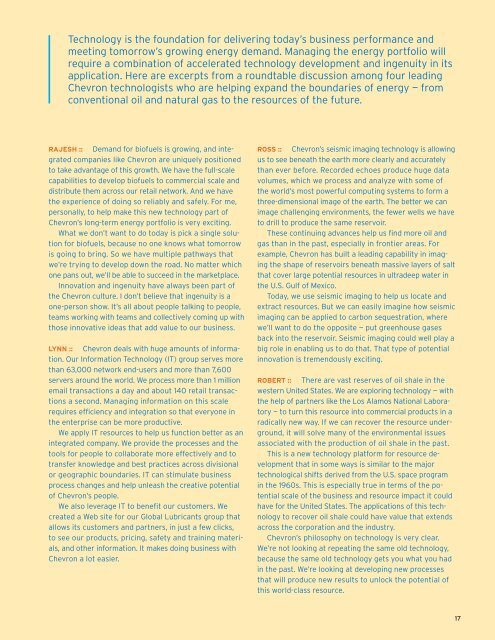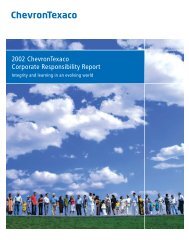Chevron 2006 Annual Report
Chevron 2006 Annual Report
Chevron 2006 Annual Report
Create successful ePaper yourself
Turn your PDF publications into a flip-book with our unique Google optimized e-Paper software.
Technology is the foundation for delivering today’s business performance and<br />
meeting tomorrow’s growing energy demand. Managing the energy portfolio will<br />
require a combination of accelerated technology development and ingenuity in its<br />
application. Here are excerpts from a roundtable discussion among four leading<br />
<strong>Chevron</strong> technologists who are helping expand the boundaries of energy — from<br />
conventional oil and natural gas to the resources of the future.<br />
RAJESH :: Demand for biofuels is growing, and integrated<br />
companies like <strong>Chevron</strong> are uniquely positioned<br />
to take advantage of this growth. We have the full-scale<br />
capabilities to develop biofuels to commercial scale and<br />
distribute them across our retail network. And we have<br />
the experience of doing so reliably and safely. For me,<br />
personally, to help make this new technology part of<br />
<strong>Chevron</strong>’s long-term energy portfolio is very exciting.<br />
What we don’t want to do today is pick a single solution<br />
for biofuels, because no one knows what tomorrow<br />
is going to bring. So we have multiple pathways that<br />
we’re trying to develop down the road. No matter which<br />
one pans out, we’ll be able to succeed in the marketplace.<br />
Innovation and ingenuity have always been part of<br />
the <strong>Chevron</strong> culture. I don’t believe that ingenuity is a<br />
one-person show. It’s all about people talking to people,<br />
teams working with teams and collectively coming up with<br />
those innovative ideas that add value to our business.<br />
LYNN :: <strong>Chevron</strong> deals with huge amounts of information.<br />
Our Information Technology (IT) group serves more<br />
than 63,000 network end-users and more than 7,600<br />
servers around the world. We process more than 1 million<br />
email transactions a day and about 140 retail transactions<br />
a second. Managing information on this scale<br />
requires efficiency and integration so that everyone in<br />
the enterprise can be more productive.<br />
We apply IT resources to help us function better as an<br />
integrated company. We provide the processes and the<br />
tools for people to collaborate more effectively and to<br />
transfer knowledge and best practices across divisional<br />
or geographic boundaries. IT can stimulate business<br />
process changes and help unleash the creative potential<br />
of <strong>Chevron</strong>’s people.<br />
We also leverage IT to benefit our customers. We<br />
created a Web site for our Global Lubricants group that<br />
allows its customers and partners, in just a few clicks,<br />
to see our products, pricing, safety and training materials,<br />
and other information. It makes doing business with<br />
<strong>Chevron</strong> a lot easier.<br />
ROSS :: <strong>Chevron</strong>’s seismic imaging technology is allowing<br />
us to see beneath the earth more clearly and accurately<br />
than ever before. Recorded echoes produce huge data<br />
volumes, which we process and analyze with some of<br />
the world’s most powerful computing systems to form a<br />
three-dimensional image of the earth. The better we can<br />
image challenging environments, the fewer wells we have<br />
to drill to produce the same reservoir.<br />
These continuing advances help us find more oil and<br />
gas than in the past, especially in frontier areas. For<br />
example, <strong>Chevron</strong> has built a leading capability in imaging<br />
the shape of reservoirs beneath massive layers of salt<br />
that cover large potential resources in ultradeep water in<br />
the U.S. Gulf of Mexico.<br />
Today, we use seismic imaging to help us locate and<br />
extract resources. But we can easily imagine how seismic<br />
imaging can be applied to carbon sequestration, where<br />
we’ll want to do the opposite — put greenhouse gases<br />
back into the reservoir. Seismic imaging could well play a<br />
big role in enabling us to do that. That type of potential<br />
innovation is tremendously exciting.<br />
ROBERT :: There are vast reserves of oil shale in the<br />
western United States. We are exploring technology — with<br />
the help of partners like the Los Alamos National Laboratory<br />
— to turn this resource into commercial products in a<br />
radically new way. If we can recover the resource underground,<br />
it will solve many of the environmental issues<br />
associated with the production of oil shale in the past.<br />
This is a new technology platform for resource development<br />
that in some ways is similar to the major<br />
technological shifts derived from the U.S. space program<br />
in the 1960s. This is especially true in terms of the potential<br />
scale of the business and resource impact it could<br />
have for the United States. The applications of this technology<br />
to recover oil shale could have value that extends<br />
across the corporation and the industry.<br />
<strong>Chevron</strong>’s philosophy on technology is very clear.<br />
We’re not looking at repeating the same old technology,<br />
because the same old technology gets you what you had<br />
in the past. We’re looking at developing new processes<br />
that will produce new results to unlock the potential of<br />
this world-class resource.<br />
17

















